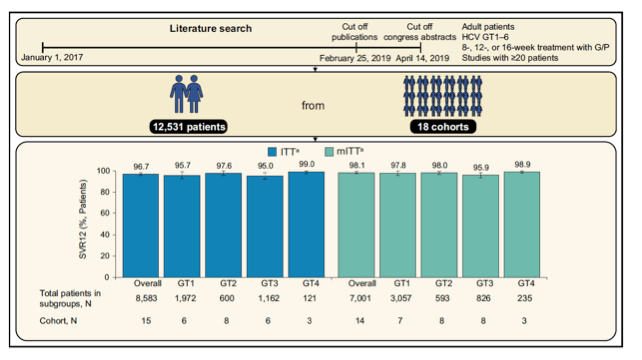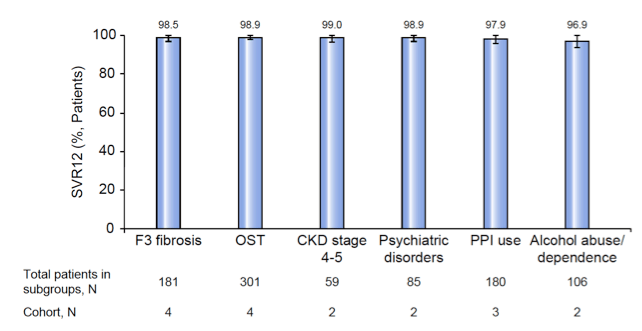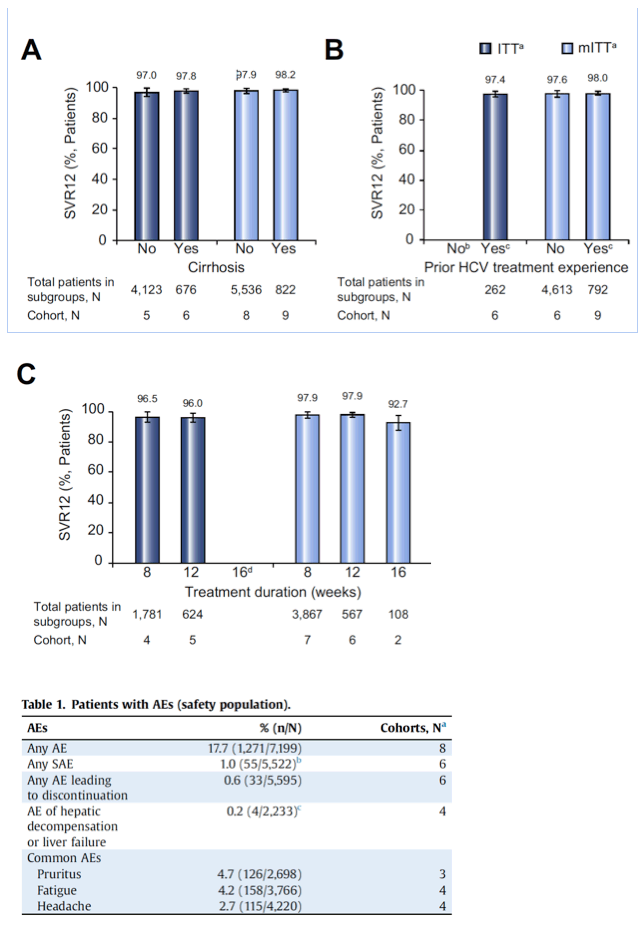| |
|
Real-world effectiveness and safety of glecaprevir/pibrentasvir for the treatment of patients with chronic HCV infection: A meta-analysis
|
| |
| |
Download the PDF here
Jnl of Hepatology June 1 2020 - Pietro Lampertico1,*,†, Jose A. Carrión2, Michael Curry3, Juan Turnes4, Markus Cornberg5, Francesco Negro6, Ashley Brown7, Marcello Persico8,†, Nicole Wick9, Ariel Porcalla10, Andreas Pangerl10, Eric Crown10, Lois Larsen10, Yao Yu10, Heiner Wedemeyer11
In conclusion, the results of this meta-analysis demonstrate that the real-world effectiveness and safety of glecaprevir/pibrentasvir in more than 12,000 patients were consistent with those observed in clinical trials. Furthermore, real-world evidence indicates that glecaprevir/pibrentasvir is a highly effective and well-tolerated pangenotypic treatment option for a broad range of patients with chronic HCV infection, regardless of patient characteristics, supporting its use in HCV eradication programs and its inclusion in the WHO clinical recommendations to adopt a pangenotypic DAA regimen and to treat all patients.
Lay summary
It is important to assess treatments for hepatitis C virus (HCV) in the real world, as patient populations tend to be more diverse and potentially less adherent to treatment compared to those in clinical trials. Results from 18 studies performed in real-world clinics were pooled and analyzed to investigate the effectiveness and safety of a direct-acting antiviral combination (glecaprevir/pibrentasvir) in routine clinical practice. This analysis showed that glecaprevir/pibrentasvir is highly effective and well tolerated across all HCV genotypes and patient groups studied. It also showed that results seen in the real world are similar to the results seen in clinical trials, even in patients historically considered more challenging to treat.
The overall mITT SVR12 rate was also high in this meta-analysis (98.1%) and comparable with that observed in clinical trials (99.1%).
The virologic failure rate was 2.4%. Because the mITT population for the VA cohort included patients without an SVR12 rate as well as those with virologic failure, sensitivity analyses of the SVR12 rates for the mITT population were conducted excluding the VA cohort. In these sensitivity analyses, the overall SVR12 rate was 98.9% and the virologic failure rate was 1.2%, similar to the rates seen in registrational trials.
It is important to report mITT SVR12 rates in subpopulations in which there is suspicion of lower efficacy; thus, mITT SVR12 rates were presented for most cohorts by labeled regimen or comorbidities. Looking at subpopulations of interest, the mITT SVR12 rate in patients who used OST in this meta-analysis (98.9%) was similar to the mITT rate reported in patients receiving OST in clinical trials (99.3%) in which adherence to treatment was high (98%). This is particularly important given the evolving epidemiology of HCV in some countries. The number of younger people with milder disease (fibrosis stage F0-F1) who are infected with HCV is increasing, and the majority of new cases in these younger patients occur in those who use illicit injectable drugs. The mITT SVR12 rate in patients with CKD stage 4-5 in this meta-analysis (99.0%) was also similar to that reported in a clinical study (100%).
The introduction of highly effective DAA therapies with short durations of treatment that can cure HCV infection has transformed the treatment landscape in recent years. In this meta-analysis, the SVR12 rates were high in patients who received glecaprevir/pibrentasvir treatment for 8 weeks (96.5% in the ITT population and 97.9% in the mITT population). In treatment-naïve patients without cirrhosis who received on-label treatment for 8 weeks, the mITT SVR12 rate was 99.3%, similar to that seen in the glecaprevir/pibrentasvir clinical development program (99.2%). One group of particular interest is patients infected with HCV GT3 as they are considered a more difficult-to-treat population. The SVR12 rate for treatment-naïve patients with GT3 treated for 8 weeks with glecaprevir/pibrentasvir in this meta-analysis of real-world data was 99.2% (mITT population), which is higher than the rates seen in the registrational trials (ITT SVR12, 95.2%; mITT SVR12, 97.5%). For HCV-infected patients with compensated cirrhosis, current international guidelines for HCV management recommend treatment for at least 12 weeks. In this meta-analysis, the mITT SVR12 rate was 99.0% in treatment-naïve patients with compensated cirrhosis who received on-label treatment for 12 weeks. Data suggest that an 8-week treatment course with glecaprevir/pibrentasvir may be as effective as a 12-week treatment course in HCV treatment-naïve patients with compensated cirrhosis. A clinical trial using an 8-week treatment regimen for treatment-naïve patients infected with HCV GT1-6 infection who have compensated cirrhosis has been completed. At the time of this meta-analysis, there were no pangenotypic regimens approved for 8 weeks in all treatment-naïve patients with compensated cirrhosis. Based on the results of EXPEDITION-8 study, the European Medicines Agency has granted marketing authorization and the US Food and Drug Administration has approved the use of glecaprevir/pibrentasvir for 8 weeks in treatment-naïve patients with compensated cirrhosis and HCV genotypes 1-6.
In May 2016, the World Health Assembly adopted the World Health Organization (WHO) Global Health Sector Strategy on Viral Hepatitis, 2016‒2021. The aim is to eliminate HCV as a major public health threat by 2030, by reducing new infections by 80% and HCV-related deaths by 65%, which requires 90% of individuals with chronic HCV infection to be diagnosed and 80% of those diagnosed to be treated. In 2015, only 20% (14 million) of the estimated 71 million individuals living with chronic HCV worldwide were aware that they were infected, and in 2016, only 13% of those aware of having chronic HCV were being treated. To help eradicate HCV, the WHO recommends treating all adults with chronic HCV infection and advocates using pangenotypic DAA regimens, which they state are highly effective and well tolerated with only minor adverse effects, based on data from clinical studies. The tolerability profile of glecaprevir/pibrentasvir in this meta-analysis was similar to that reported in ~2,300 patients participating in the clinical development program, with headache and fatigue among the most commonly reported AEs and <1% of patients discontinuing treatment because of AEs. Pruritus was the most common AE reported in this meta-analysis, possibly mediated at least in part by DAA-driven alterations to bile acid metabolism or protease regulation. Additionally, pruritus is commonly observed in specific HCV-infected populations, such as patients with renal impairment or cirrhosis. These populations are represented in the cohorts included in this meta-analysis. Hepatic decompensation events were rare (reported in <0.2% of patients). Information regarding these events and the patients who developed these events are not available, precluding further analysis. Taken together, these real-world data support the use of pangenotypic glecaprevir/pibrentasvir in all patients with HCV, irrespective of whether they were historically considered more challenging to treat, to help achieve the WHO goal of HCV elimination.

Efficacy analyses: SVR12 rates, overall and by subgroups
SVR12 rates for the mITT populations were similar to those in the ITT populations for all subgroups (Fig. 3, Fig. 4A‒C). In a sensitivity analysis that excluded the VA cohort, SVR12 rates for the mITT populations were 98.9% overall and 99.6%, 98.9%, 97.2% and 98.9% for GT1, GT2, GT3, and GT4 subgroups, respectively (Fig. S1). SVR12 rates were also improved in subgroups by cirrhosis status, treatment experience, and treatment duration when the VA cohort was excluded (Fig. S2A-C).
The virologic failure rate in the mITT population was 2.4% (n/N = 165/7,001). Of the 165 virologic failures, 91 patients from the VA cohort were considered virologic failures as they did not have SVR12 data in the mITT population.
30 When data from the VA cohort were excluded (sensitivity analysis), the virologic failure rate in the mITT population was 1.2% (74/5,834). No information was available on resistance-associated substitutions.
SVR12 rates in treatment-naïve patients who received on-label treatment and by subgroup of interest
The SVR12 rate in the ITT population for treatment-naïve patients without cirrhosis who received on-label treatment (glecaprevir/pibrentasvir for 8 weeks; n = 697; 2 cohorts) was 98.2% (95% CI 96.7-99.6). The mITT SVR12 rate for treatment-naïve patients without cirrhosis who received on-label treatment for 8 weeks (n = 3,657; 9 cohorts) was 99.3% (95% CI 98.8-99.7); SVR12 rates for GT1-4 ranged from 98.3% to 99.6% (Fig. 5A). There were insufficient ITT data available (<2 cohorts) for treatment-naïve patients with compensated cirrhosis who received on-label treatment (glecaprevir/pibrentasvir for 12 weeks). The mITT SVR12 rate in patients with compensated cirrhosis who received on-label treatment for 12 weeks (n = 362; 7 cohorts) was 99.0% (95% CI 97.9‒100) (Fig. 5B).
There were insufficient data available (<2 cohorts) for an analysis of SVR12 rates in the ITT population for subgroups of interest. SVR12 rates in the mITT population, in subgroups of interest, were as follows: F3 fibrosis (n = 181; 4 cohorts): 98.5% (95% CI 96.8-100); OST (n = 301; 4 cohorts): 98.9% (95% CI 97.8-100); CKD stage 4-5 (n = 59; 2 cohorts): 99.0% (95% CI 96.5-100); psychiatric disorder (n = 85; 2 cohorts): 98.9 (95% CI 96.8-100); PPI use (n = 180; 3 cohorts): 97.9% (95% CI 95.8-100); alcohol abuse/dependency (n = 106; 2 cohorts): 96.9% (95% CI 93.6-100) (Fig. 6).
Fig. 5SVR12 rates in patients receiving on-label treatment (mITT populationa).
(A) Treatment-naïve patients without cirrhosis who received treatment for 8 weeks; (B) Treatment-naïve patients with cirrhosis who received treatment for 12 weeks.b
amITT population excluded patients from the ITT population who did not achieve SVR12 for reasons other than virologic failure. bGT3 and GT4 reported in 1 cohort. Error bars represent 95% confidence intervals. GT, genotype; ITT, intention-to-treat; mITT, modified intention-to-treat; SVR12, sustained virologic response at post-treatment week 12.

Highlights
• Meta-analysis of real-world data from 12,583 patients taking
glecaprevir/pibrentasvir.
• Glecaprevir/pibrentasvir achieved 96.7% virologic cure overall.
• Virologic cure was ≥95% across subgroups of interest.
• Serious adverse events were reported in 1.0% of patients.
• Effectiveness and safety results were consistent with those from clinical trials.
Fig. 4. SVR12 rates by subgroups. (A) Cirrhosis status; (B) Prior HCV treatment experience; (C) Prescribed treatment duration. aITT population included patients treated with >- 1 dose of glecaprevir/pibrentasvir and with SVR12 data available, discontinued early, or who were lost to follow-up; mITT population excluded patients who did not achieve SVR12 for reasons other than virologic failure. ITT and mITT analyses included patients from different cohorts. bData in treatment naïve ITT populations reported in <2 cohorts. cTreatment experience included prior HCV treatment with (pegylated) interferon, ribavirin, and/or DAAs according to local labels. dData for 16 weeks' treatment duration in ITT populations reported in <2 cohorts. Error bars represent 95% confidence intervals. DAA, direct-acting antiviral; ITT, intention-to-treat; mITT, modified intention-to-treat; SVR12, sustained virologic response at post-treatment week 12.

Safety analysis
Safety data were summarized for 7,199 patients (safety population; 8 cohorts), and AEs were reported in 1,271 patients (17.7%, Table 1). No single AE was reported with a frequency above 5%; the most frequently reported AEs were pruritus (4.7%), fatigue (4.2%), and headache (2.7%). Six cohorts included data on SAEs: these were reported in 55 of 5,522 patients (1.0%; including 1 severe AE). In total, 33 of 5,595 patients (0.6%) discontinued study treatment because of an AE across the 6 cohorts in which these data were reported. Four patients (4/2,233, 0.2%) who received glecaprevir/pibrentasvir had documented hepatic decompensation events (ascites, n = 1; esophageal varices rupture, n = 1; jaundice, n = 2; Table 2).
Abstract
Background & Aims
Glecaprevir/pibrentasvir is approved for treating adults infected with HCV genotypes 1-6. In clinical trials, glecaprevir/pibrentasvir was associated with high rates of sustained virologic response at post-treatment week 12 (SVR12) and was well tolerated. A systematic review and meta-analysis of the real-world effectiveness and safety of glecaprevir/pibrentasvir were undertaken.
Methods
Real-world studies reporting SVR12 in adults with HCV infection (n ≥20) treated with glecaprevir/pibrentasvir were identified in journal publications from January 1, 2017, to February 25, 2019, and congress presentations through April 14, 2019. Random-effects meta-analysis was used to determine SVR12 rates using data from ≥2 cohorts; intention-to-treat (ITT) analyses included patients treated with glecaprevir/pibrentasvir who had SVR12 data available, discontinued early, or were lost to follow-up; modified ITT (mITT) analyses excluded those with non-virologic failure. Naïve pooling was used to calculate adverse event (AE) rates.
Results
Overall, 12,531 adults were treated with glecaprevir/pibrentasvir (18 cohorts). Of patients with post-treatment week 12 data, SVR12 rates were 96.7% (95% CI 95.4-98.1) in the ITT population (n = 8,583, 15 cohorts) and 98.1% (95% CI 97.1-99.2) in the mITT population (n = 7,001, 14 cohorts). SVR12 rates were ≥95% across subgroups (HCV genotype, cirrhosis status, treatment history, treatment duration, on-label treatment, and subgroups of interest). AEs were reported in 17.7% (1,271/7,199) of patients (8 cohorts). Serious AEs were reported in 1.0% (55/5,522) of patients (6 cohorts). The most frequent AEs were pruritus, fatigue, and headache. AE-related treatment discontinuations were reported in 0.6% (33/5,595) of patients (6 cohorts).
Conclusions
Consistent with clinical trials, real-world evidence indicates that glecaprevir/pibrentasvir is a well-tolerated and highly effective pangenotypic treatment for a broad range of HCV-infected patients.
Introduction
Glecaprevir/pibrentasvir is a pangenotypic, direct-acting antiviral (DAA) drug regimen, given as a once-daily, all-oral, interferon (IFN)-free, ribavirin (RBV)-free, fixed-dose combination. It was approved for the treatment of patients with chronic HCV genotypes (GT) 1-6 infection in the European Union in July 2017, in the United States in August 2017, and in Japan in September 2017. The duration of glecaprevir/pibrentasvir therapy depends on prior HCV treatment, cirrhosis status, and HCV GT. In HCV treatment-naïve patients, treatment for 8 weeks is recommended for patients without cirrhosis or with compensated cirrhosis for all GTs.
In HCV treatment-experienced patients (who failed prior treatment with pegylated IFNα + RBV ± sofosbuvir, or sofosbuvir + RBV) with GT1, 2, 4-6 infection, treatment for 8 weeks is recommended for those without cirrhosis, while 12 weeks is recommended for those with compensated cirrhosis.
In HCV treatment-experienced patients with GT3 infection, treatment for 16 weeks is recommended, irrespective of cirrhosis status, although European Association for the Study of the Liver guidelines recommend treatment for 12 weeks in treatment-experienced, non-cirrhotic, GT3-infected patients. In the United States, treatment for 16 weeks is also recommended for patients with GT1 infection who were previously treated with an NS5A inhibitor (but not an NS3/4A protease inhibitor) and 12 weeks in patients previously treated with an NS3/4A protease (but not an NS5A inhibitor), irrespective of cirrhosis status. In Japan, DAA-naïve, non-cirrhotic patients with HCV GT1 or 2 infection are treated for 8 weeks with glecaprevir/pibrentasvir. Patients with HCV GT3-6 infection, those with compensated cirrhosis, and DAA-experienced patients are treated for 12 weeks. In phase II and III multinational clinical studies, glecaprevir/pibrentasvir treatment resulted in high rates of sustained virologic response at post-treatment week 12 (SVR12) and a favorable safety profile in a broad range of patients with chronic HCV infection.
In the overall intention-to-treat (ITT) population, SVR12 was achieved in 97.5% of patients with chronic HCV infection who were treated for the recommended duration, irrespective of prior HCV treatment experience or the presence of cirrhosis.
Data from clinical trials and additional subgroup analyses have also shown that glecaprevir/pibrentasvir is efficacious in some ITT patient populations historically considered more challenging to treat, including patients aged ≥65 years (SVR12: 97.9%), those with recent or former drug use (SVR12: 96.3%), those receiving opioid substitution therapy (OST; SVR12: 96.2%), patients with severe chronic kidney disease (CKD) including those requiring dialysis (SVR12: 98.4%), liver or kidney transplant recipients (≥3 months post-transplant; SVR12: 98.0%), and patients coinfected with human immunodeficiency virus (SVR12: 98.0%). In routine clinical practice, DAA effectiveness may be lower than that seen in clinical trials because patient populations tend to be more diverse and potentially less adherent to treatment.
For many DAA regimens, a similar efficacy in real-world settings to that observed in clinical trials has already been confirmed.
However, as glecaprevir/pibrentasvir was approved for the treatment of patients with chronic HCV in the latter part of 2017, published data regarding its use in clinical practice are currently limited to a small number of real-world cohorts.
Furthermore, analyses of distinct settings and a broader analysis combining different settings and countries are currently lacking. To address this, we undertook a systematic review and meta-analysis of available real-world data reporting the effectiveness and/or safety of glecaprevir/pibrentasvir for the treatment of adults with chronic HCV infection.
Results
The estimate for SVR12 rate in the ITT population without cirrhosis (n = 4,123; 5 cohorts) was 97.0% (95% CI 94.3-99.7) and in those with compensated cirrhosis (n = 676; 6 cohorts) was 97.8% (95% CI 96.4-99.2) (Fig. 4A). ITT data were reported in <2 cohorts of HCV treatment-naïve patients and, therefore, only data in the subgroup of patients who were treatment experienced were analyzed. In HCV treatment-experienced patients (ITT population; n = 262; 6 cohorts), the SVR12 rate was 97.4% (95% CI 95.5-99.3) (Fig. 4B). The estimates for SVR12 rates in the ITT population prescribed glecaprevir/pibrentasvir for either 8 weeks (n = 1,781; 4 cohorts) or 12 weeks (n = 624; 5 cohorts) were 96.5% (95% CI 93.0-100) and 96.0% (95% CI 93.0-99.1), respectively (Fig. 4C). There were insufficient published cohort data available to evaluate SVR12 rates for patients prescribed 16 weeks of glecaprevir/pibrentasvir treatment (GT3-infected, treatment-experienced patients).
| |
| |
| |
|
|
|